80486 power on Siemens Nixdorf PCD-4ND (text and video are optional)
A small story about the Siemens Nixdorf PCD-4ND laptop and the power of the 80486DX2 / 50 MHz processor. If you do not like the video - under the cut is almost complete content in the form of text and dark-darkness photos in 1080p, made by a video camera. The laptop was presented by one of the spectators of the program, Alexey.
The laptop has survived quite well, although as a matte cover it is clear that the life of the laptop was eventful.
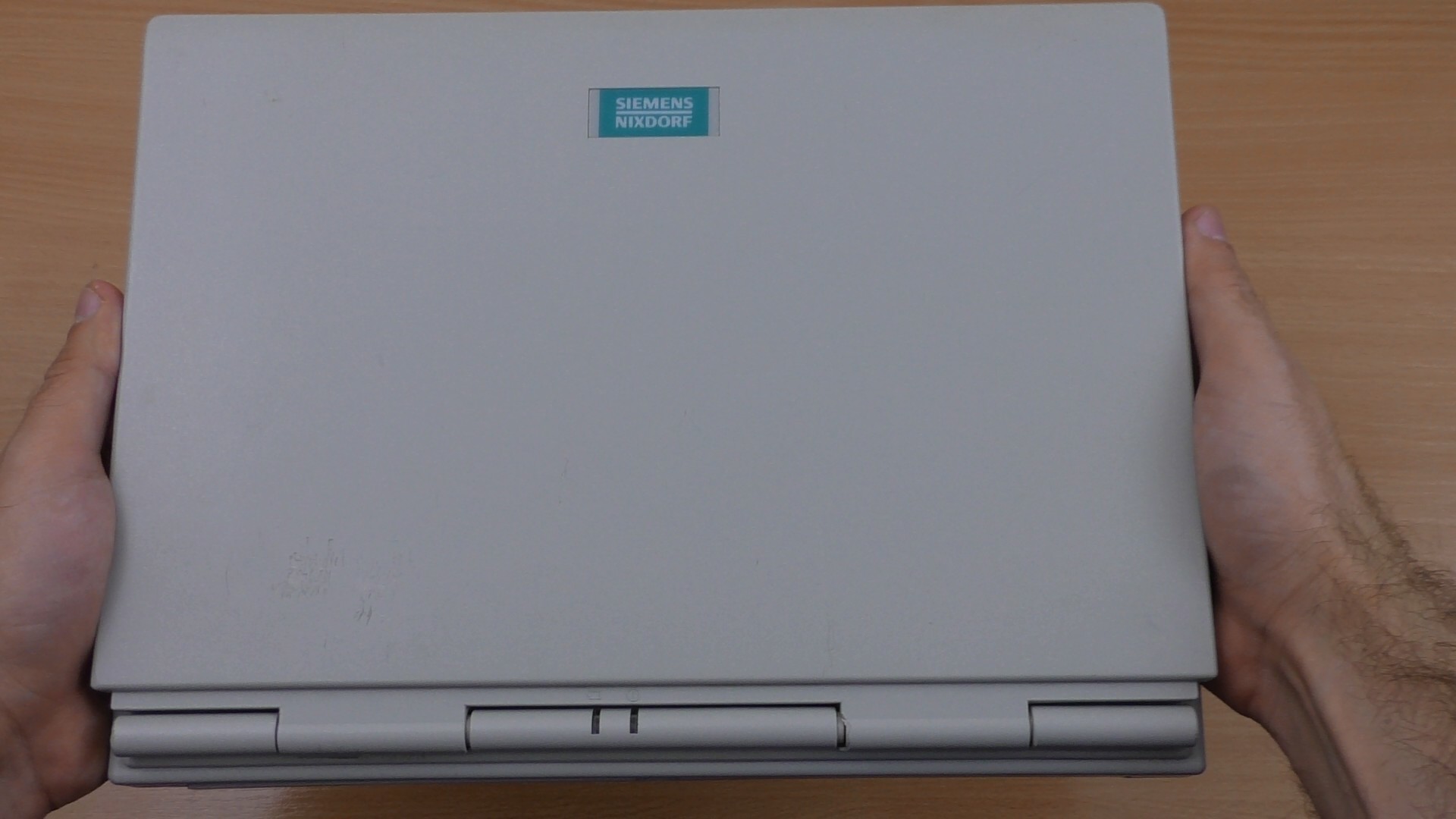
')
Nearly in the center we have a built-in microphone hiding, which is quite unusual for old laptops I have seen.
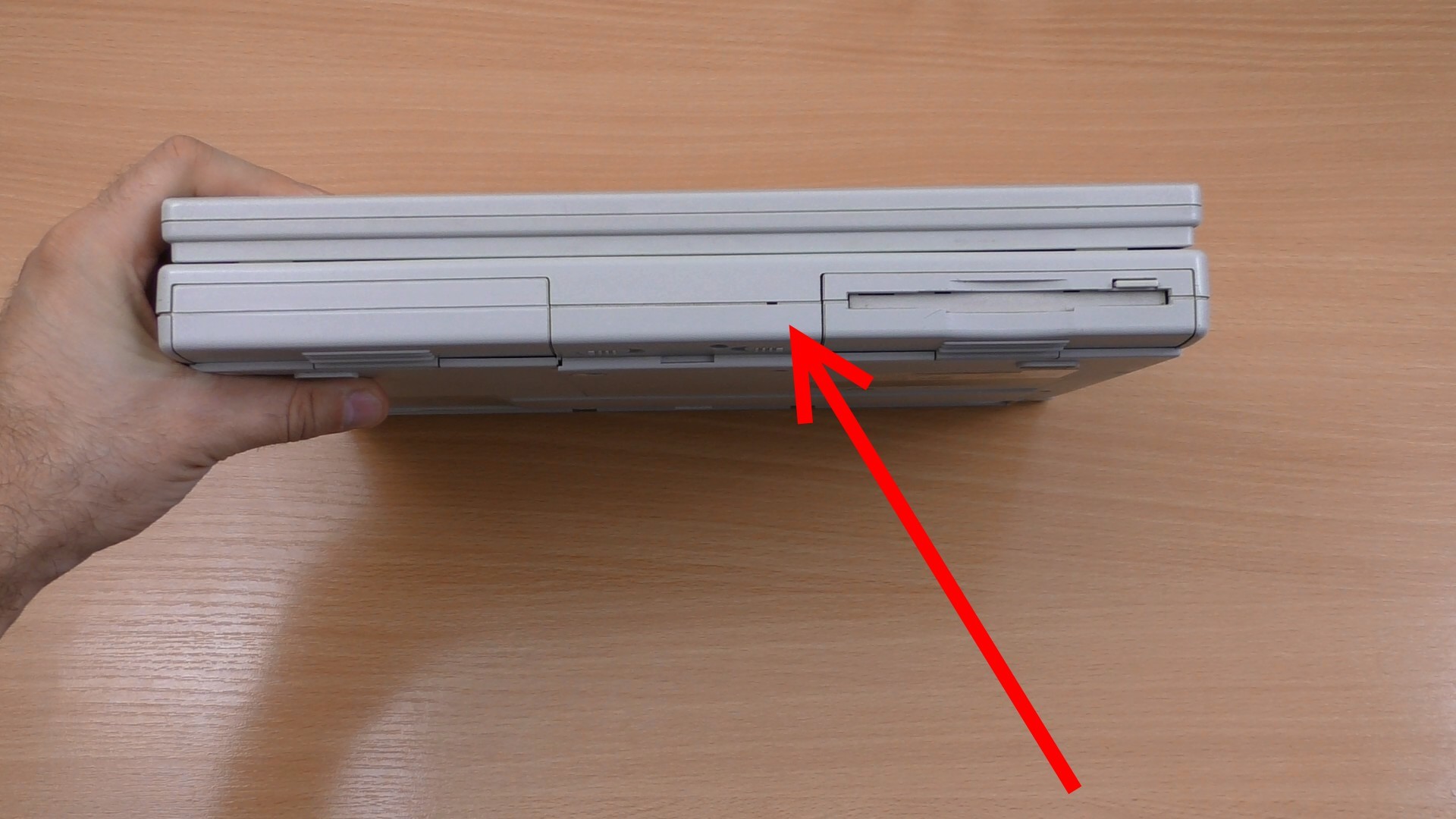
On the right is a typical drive for 3 and a half inches, and still working, and at the front left - pretty weighty, but alas, already dead battery. A striking difference from modern laptops, where the battery is most often located behind.
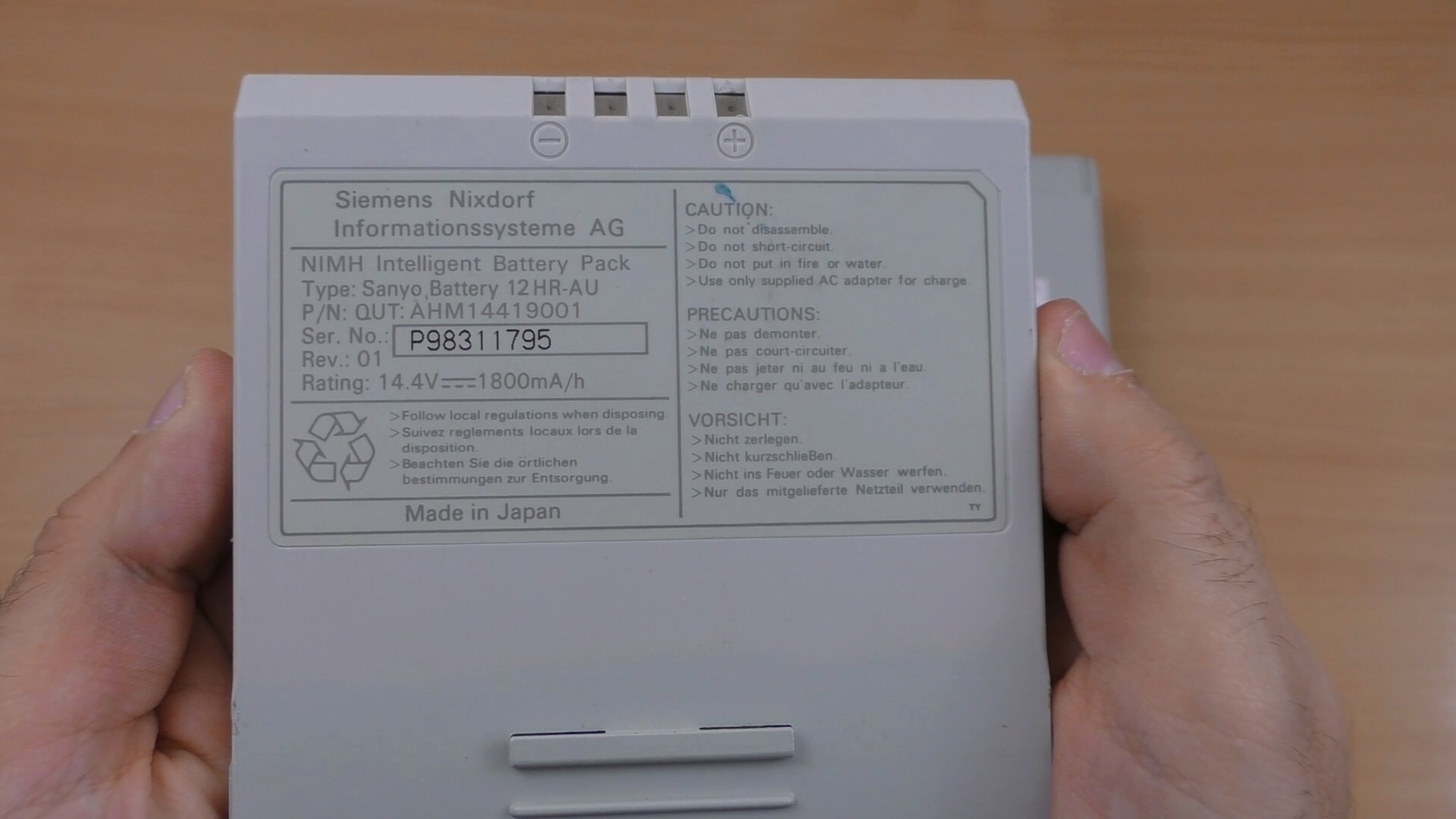

Flopik, making some significant enough effort, can also be pulled out and replaced with an additional battery. Curious move.

By the way, according to the documentation, this model was originally supplied with 4 MB of RAM, but judging by the inscriptions on the bottom cover, later revisions were upgraded to the full.

On the right, the laptop has a connector for connecting the power supply, and under the cover there are separate PS / 2 ports for connecting an external mouse and keyboard. Separate, this is important: on older laptops, sometimes these ports were combined into one.
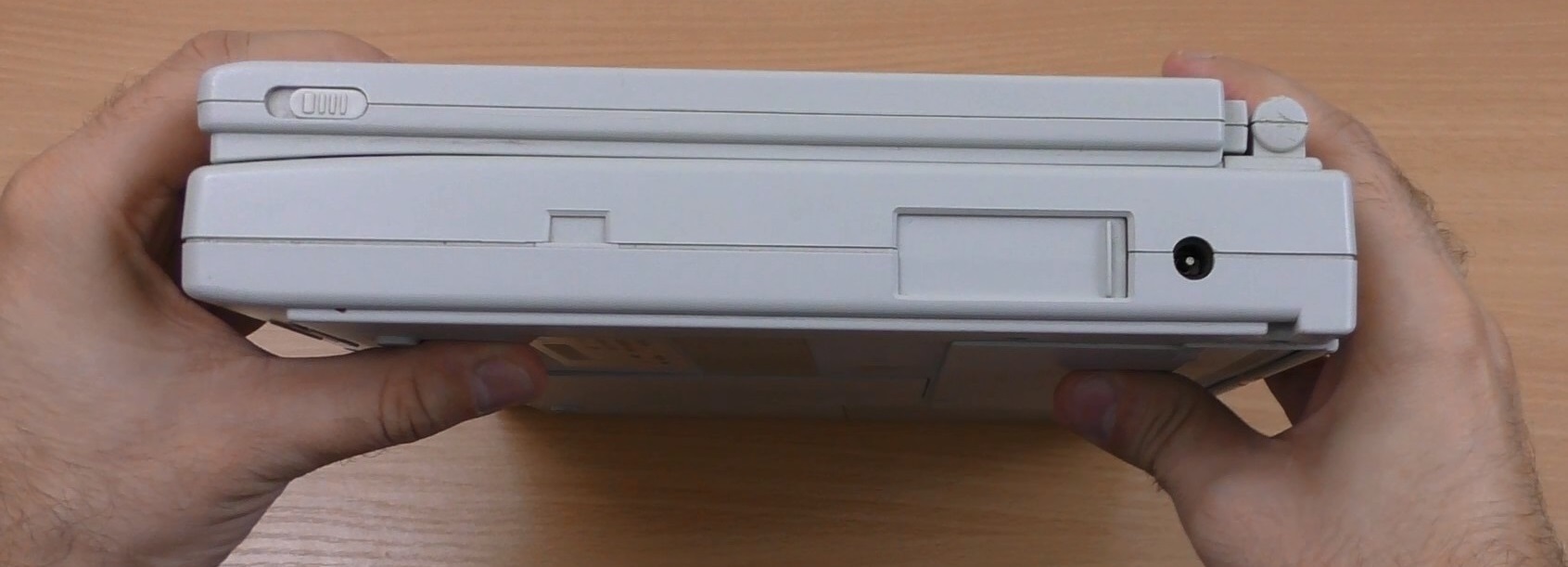

On the left are the PCMCIA connector for expansion cards like network, USB and so on. Standard connectors for connecting external speakers and, according to documentation, linear audio output huddle alongside.
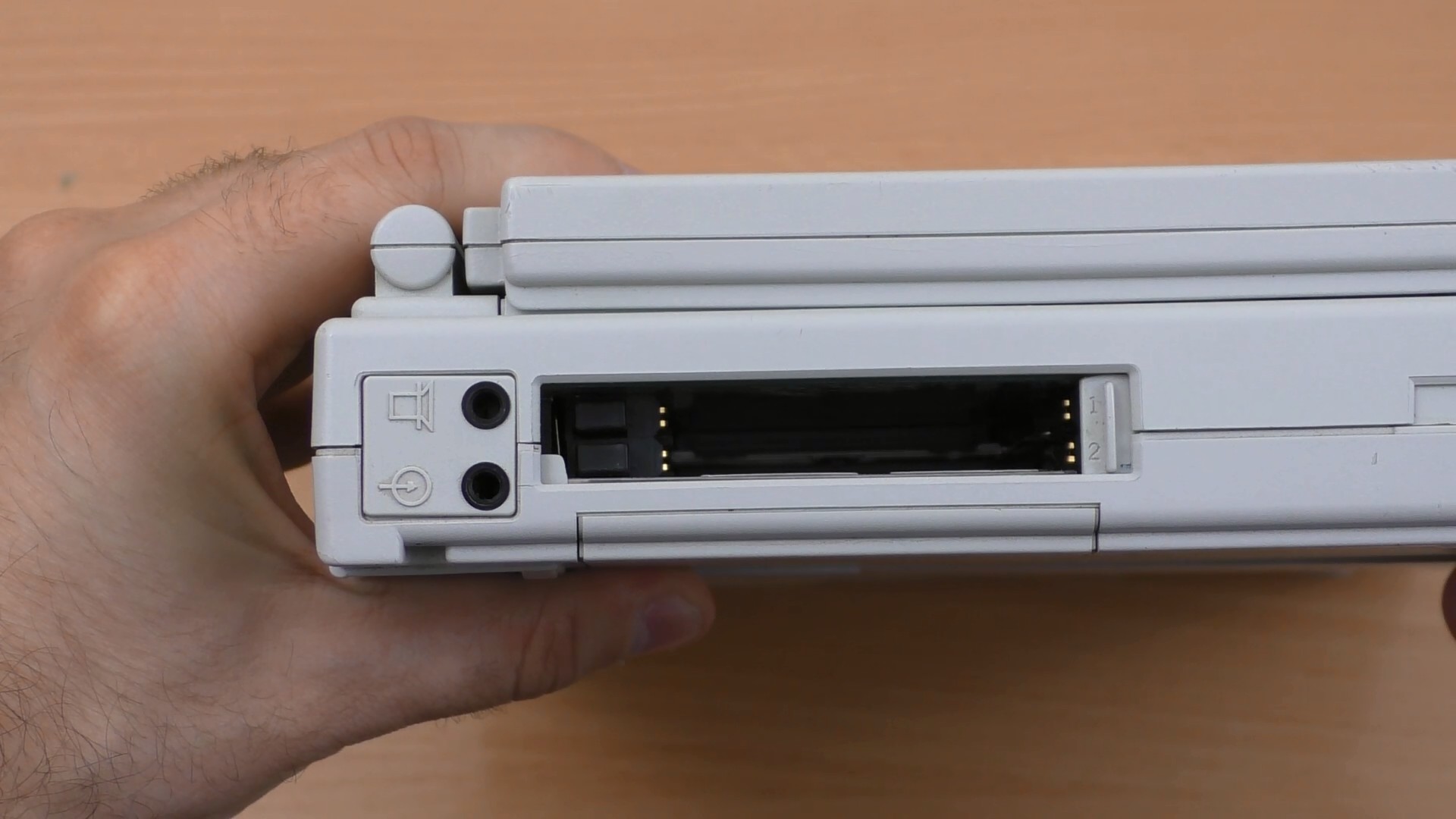
The microphone port is, oddly enough, located at the back.
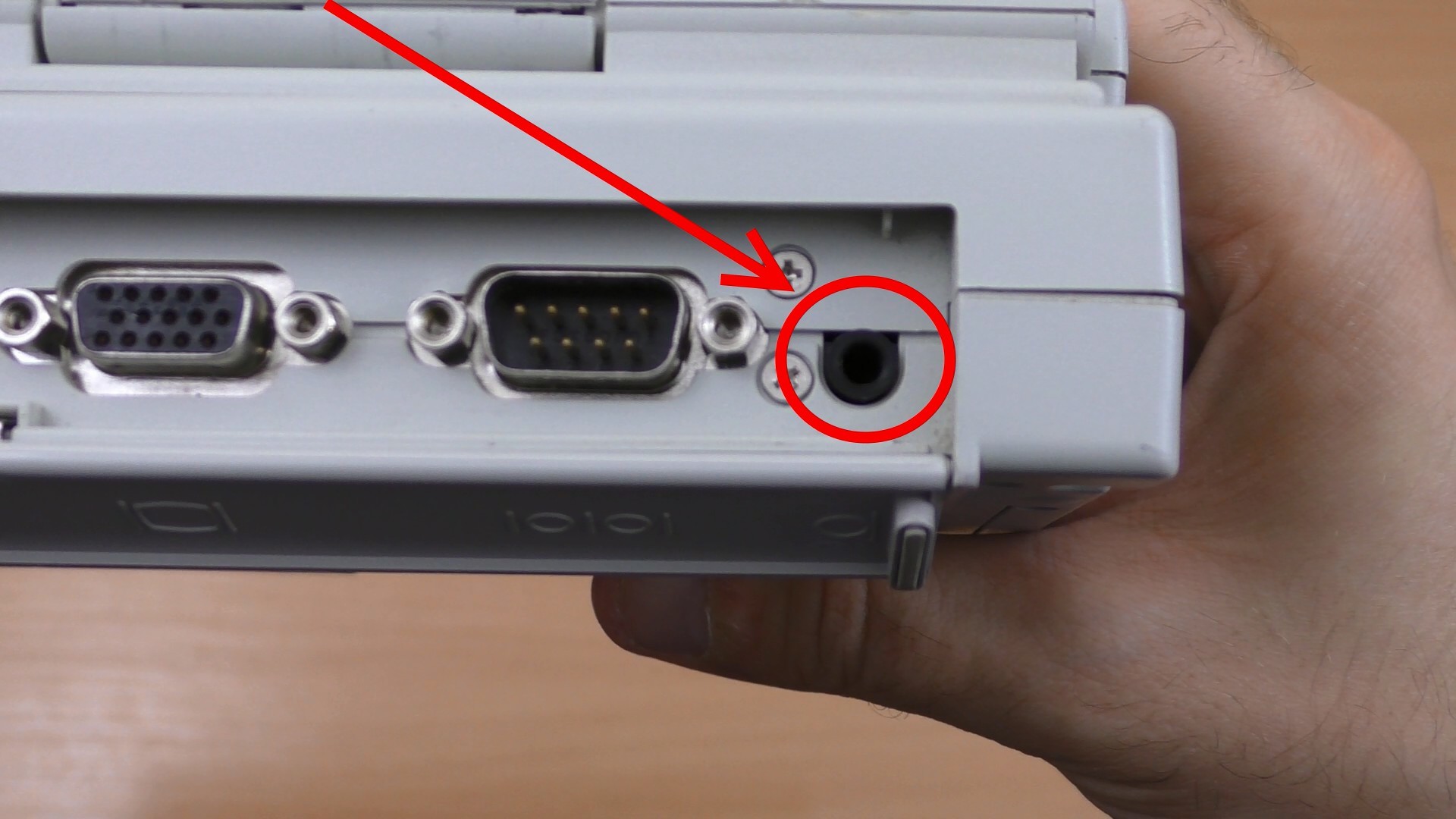
Unusual solution. Also located in the back, from right to left:
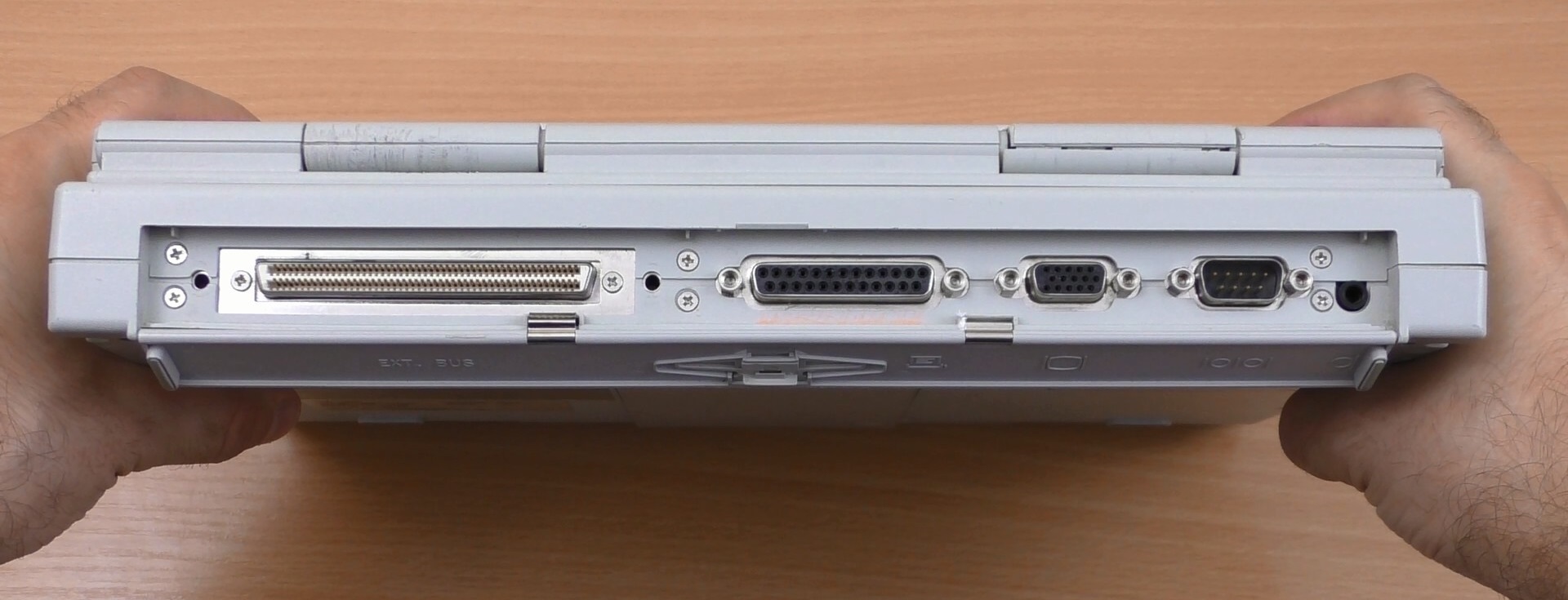
COM port for connecting mice or other slow equipment;
VGA port for connecting an external monitor;
LPT, which is also parallel, also known as a printer port, which allows the use of faster hardware;
and of course, a proprietary expansion port that allows you to connect to the docking station with additional equipment. Such docks were a typical feature of laptops of those years, but today they almost everywhere have sunk into oblivion.
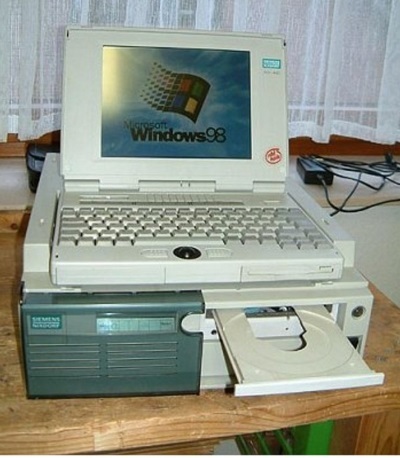
Under the lid, a 10-inch monitor is waiting for us, but unfortunately, over the years, the hinges are so well loosened, and it is not fixed in any of the positions. I deliberately did not even try to repair it in any way in order to show you how it happens in life. Personally, I see this for the first time.

Under the display, besides a pair of LED indicators, there is also a socket hiding, when turned on, showing some technical information. Funny thing, I even slightly regret that it has ceased to be fashionable.

On the right side of the speaker stays in a single copy, as well as the power button, there is nothing unusual here.

But for what purposes, except as aesthetic, this thing is needed - I do not have a single idea. To record reminders, what key does it mean? In general, if you have thoughts on this subject - write in the comments.
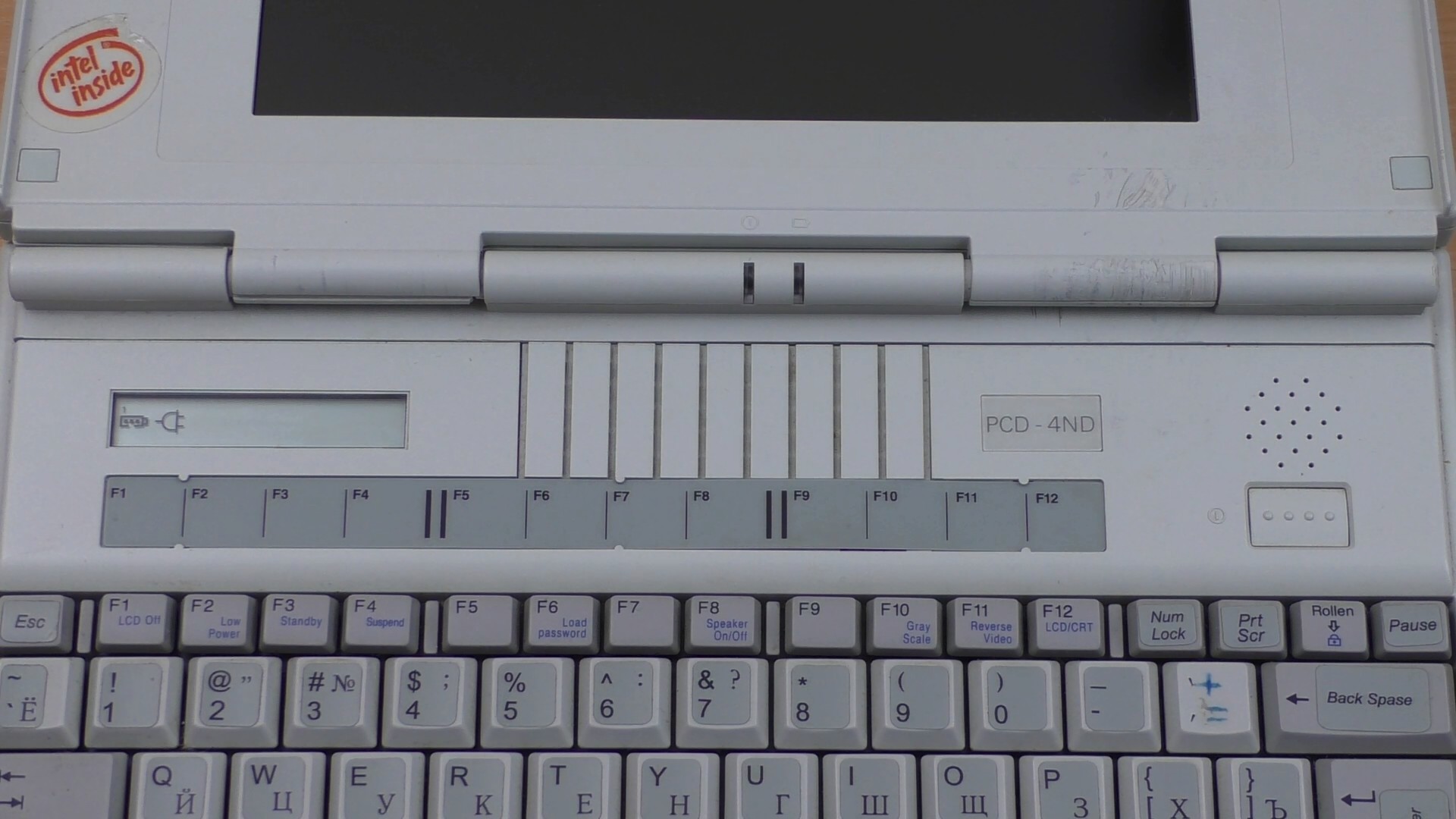
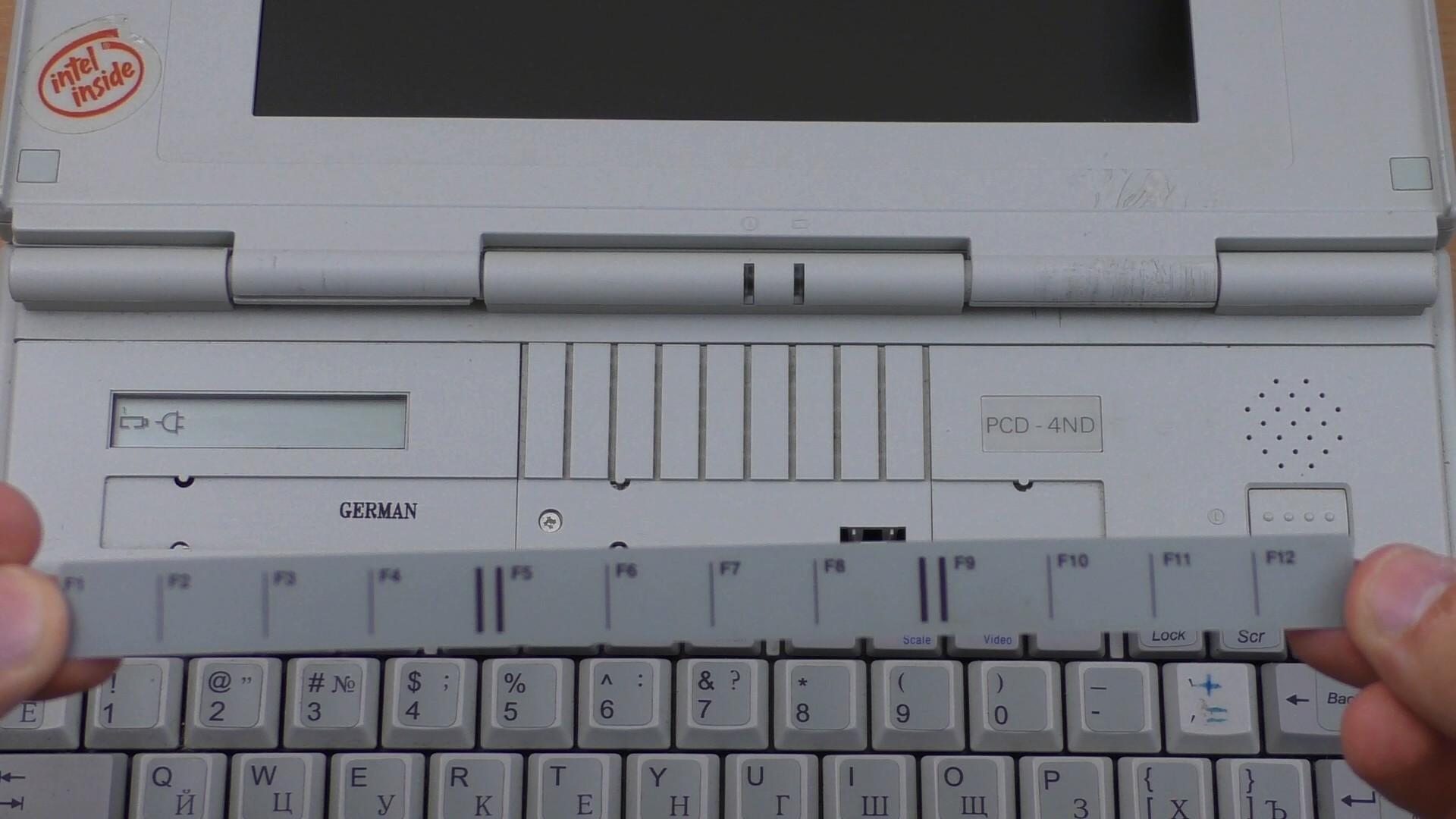
Under the keyboard is a trackball with two buttons. Quite a curious thing, the buttons are pressed well, but I personally lack sensitivity, even after cleaning the ball.
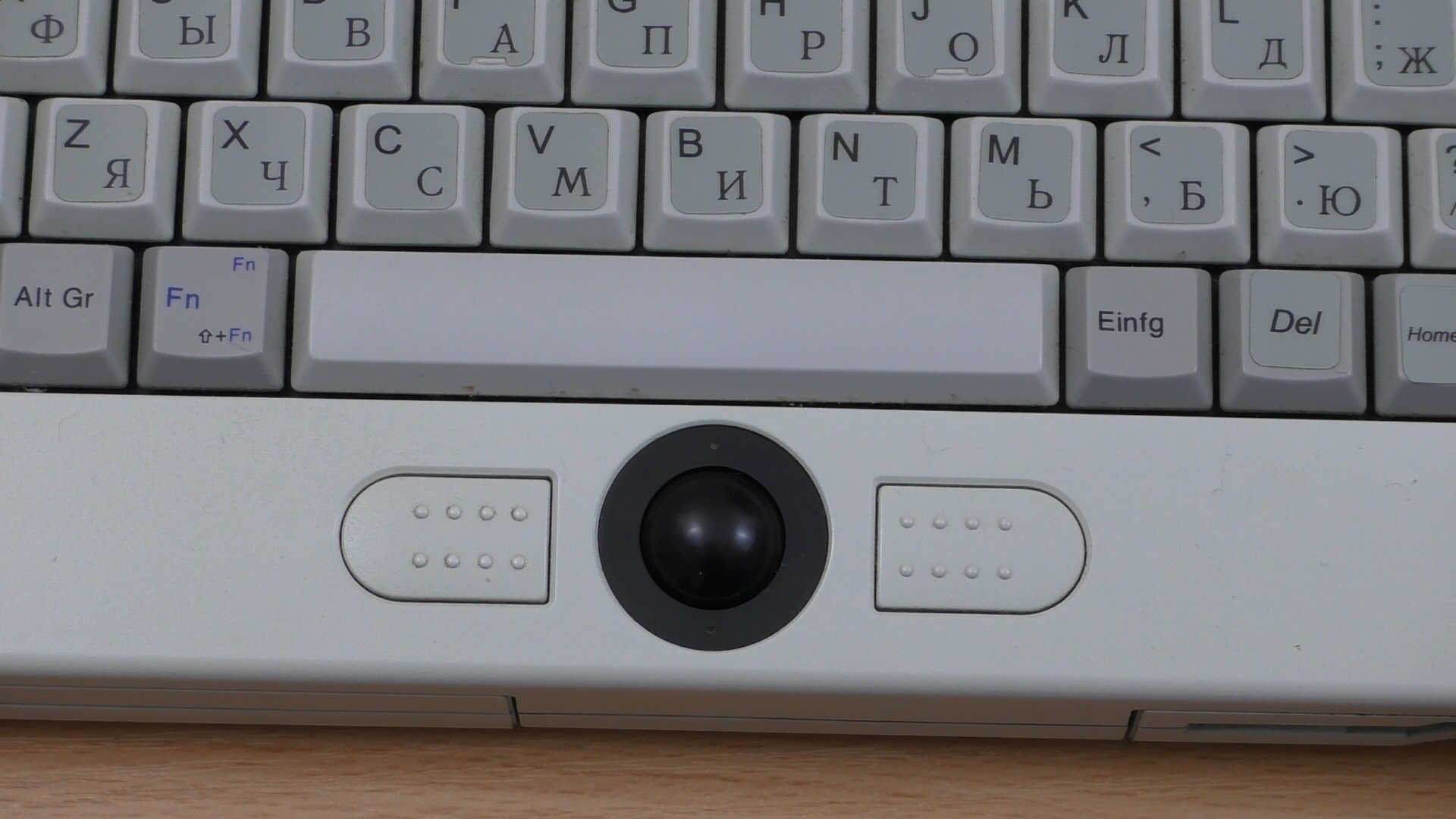
Finally, the keyboard.

As you can see, initially there were no Russian designations on it, they were pasted later, moreover, they were pasted qualitatively, and over the years they were not erased. Alas, because of the rather large keys, the delete, home and end buttons are located atypically.
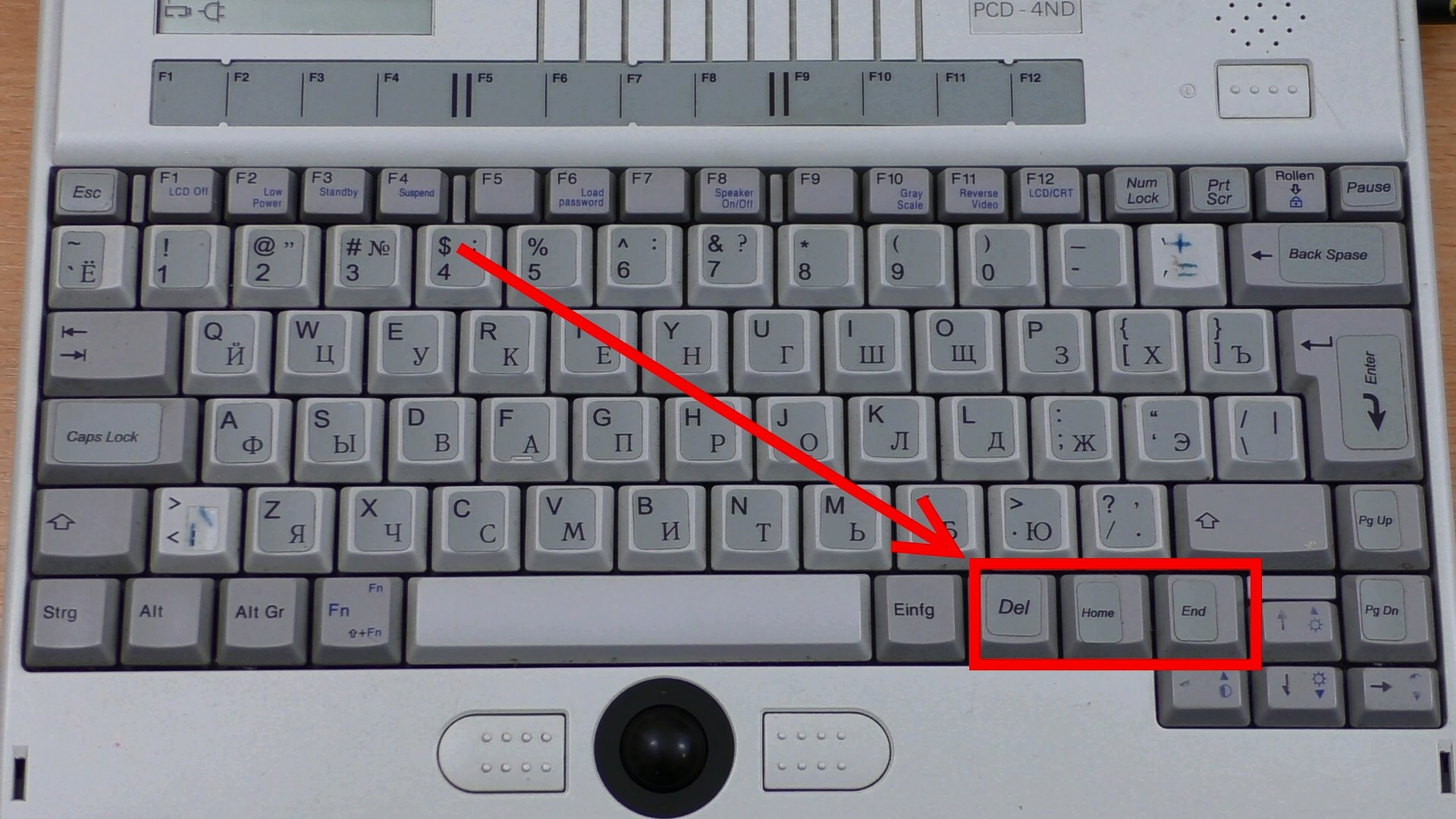
It also infuriates the location of the Fn key - on a normal keyboard in this place there is an alt, and if you try without looking at the keyboard in Windows, press the Alt + F4 combination and you go to Fn + F4 - the laptop will go to sleep, and this is very bad.
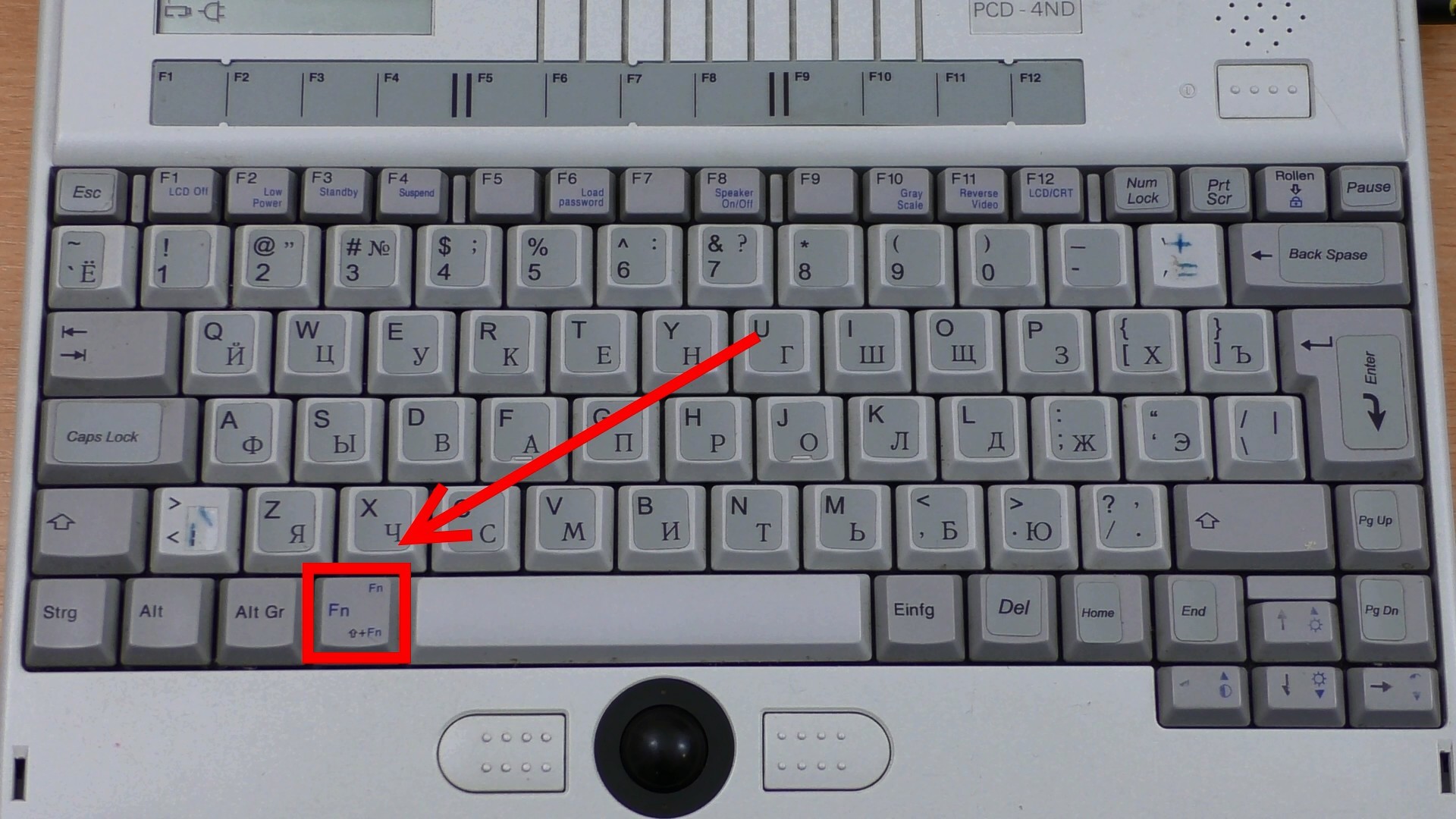
After switching on, the laptop happily reports that it already has power at 50 MHz, and that in order to go to the BIOS settings, you need to hold down the not very typical Fnc + ESCAPE key combination. These settings look pretty ordinary and include almost the same as today, say, download sequence, date change, password protection, and so on.

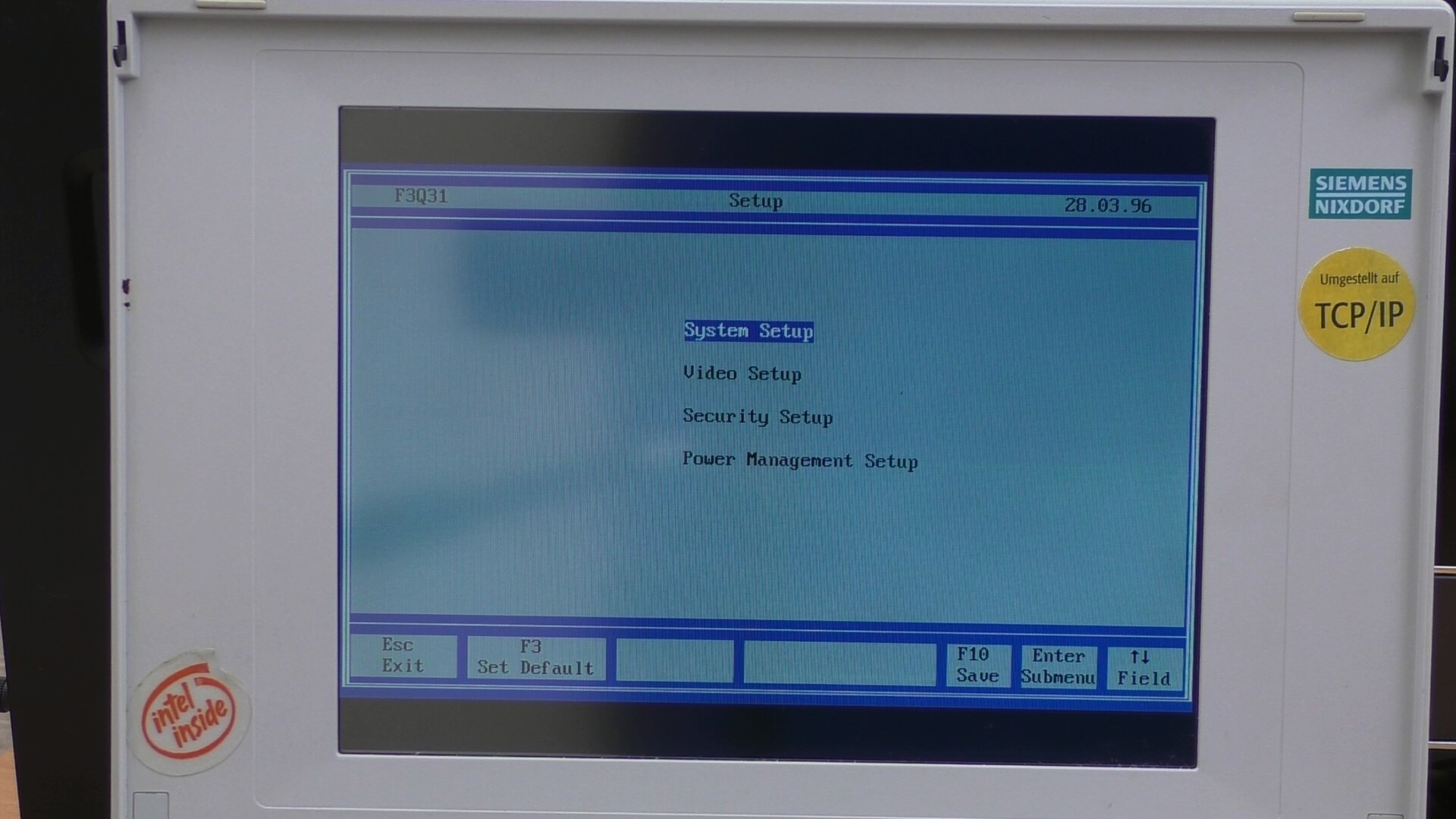

There is also a monitor mode switch, where you can choose whether to stretch the image in a low resolution with or without proportions, it did not affect the performance. The picture on the external monitor in the duplication mode will be displayed in the same mode.
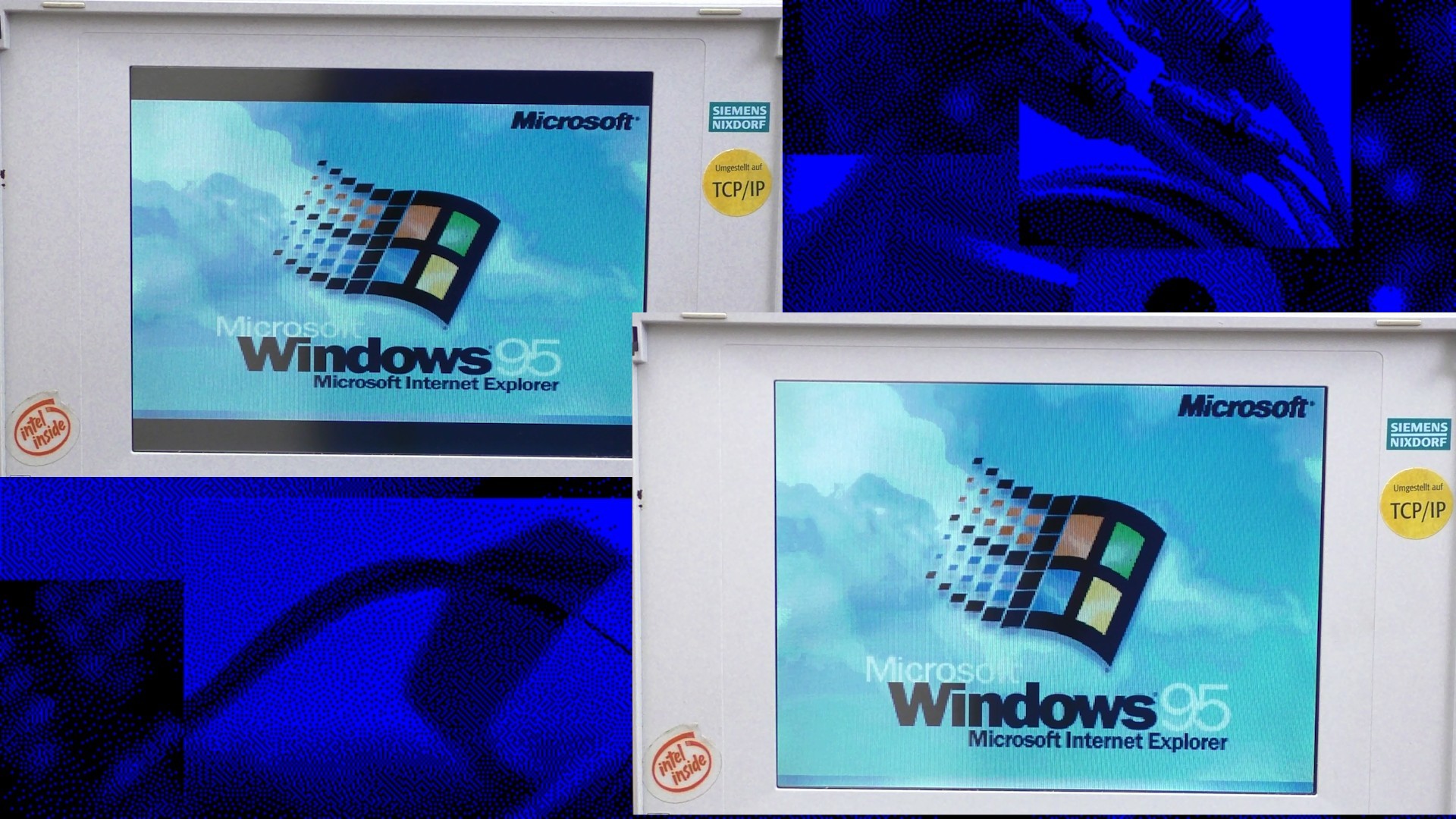
The video card here is from Western Digital, which made, as we see, not only hard drives.

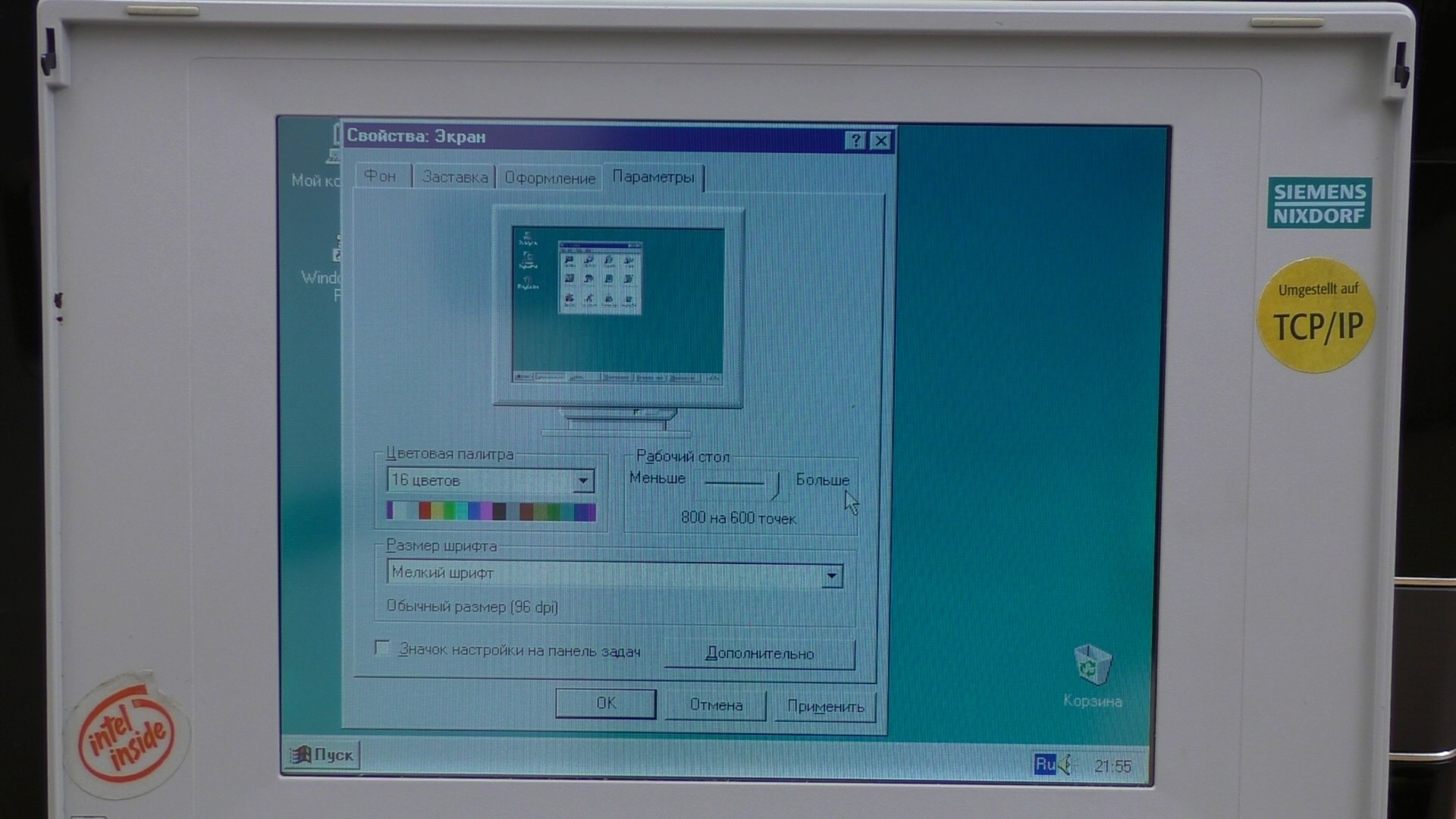
Now about performance. There is much clearer to watch the video, so in the form of text I will describe everything briefly.
Doom 2 - sometimes slows down a bit, but in general - playable. And if you reduce the size of the screen - then the brakes evaporate.

Decscent II slows down noticeably more at 320x200, and at 640x480, we switch to a slide show at all.
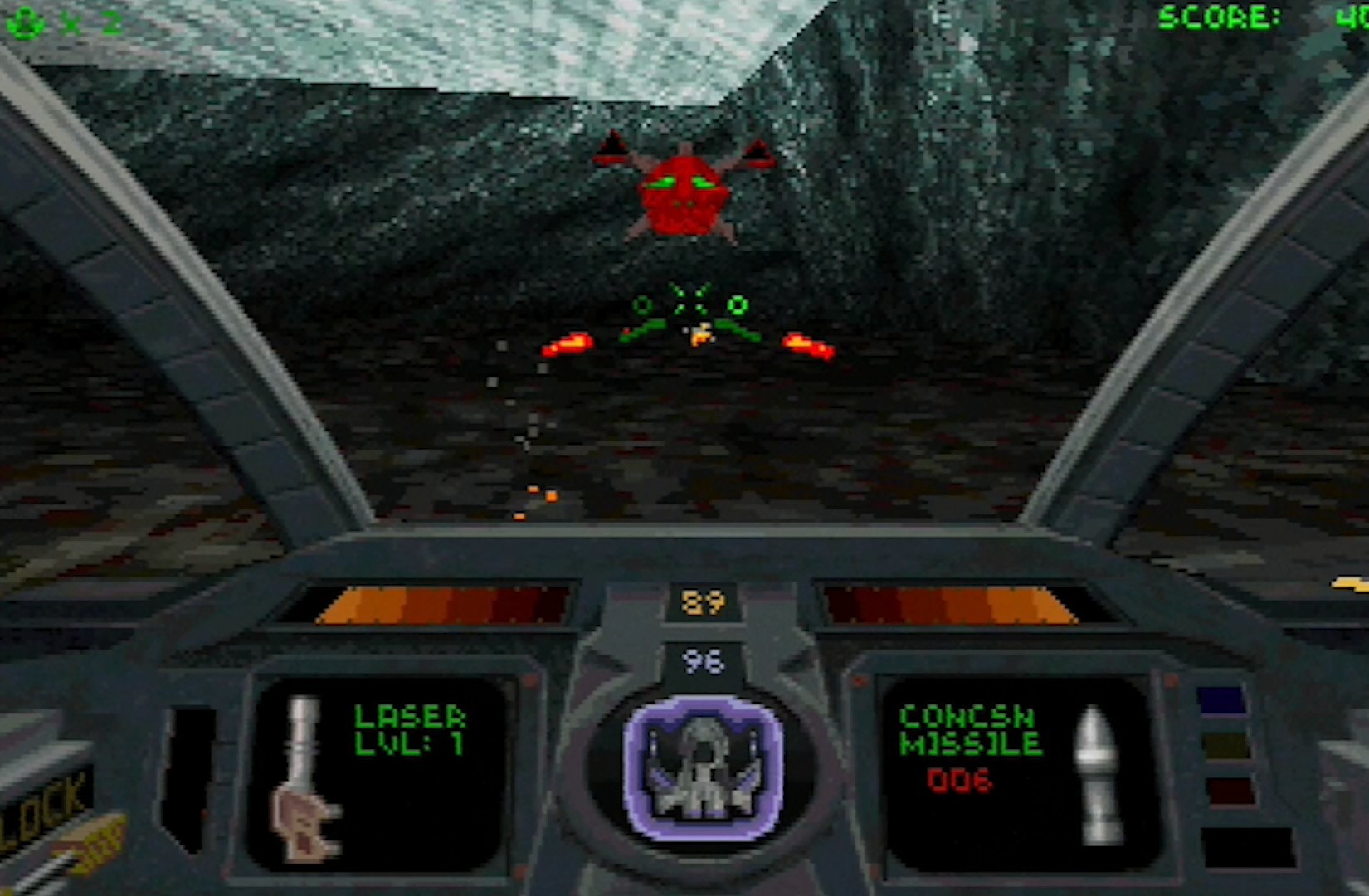
But Quake slows down as not in itself. More or less normally, you can play only 320x200 and unscrew the screen size to a minimum. The game at the same time still slows down, but everything else also becomes VERY difficult to understand what happens there damn it! The situation, however, is quite predictable: 486DX4 / 100 MHz is specified in the minimum system requirements.
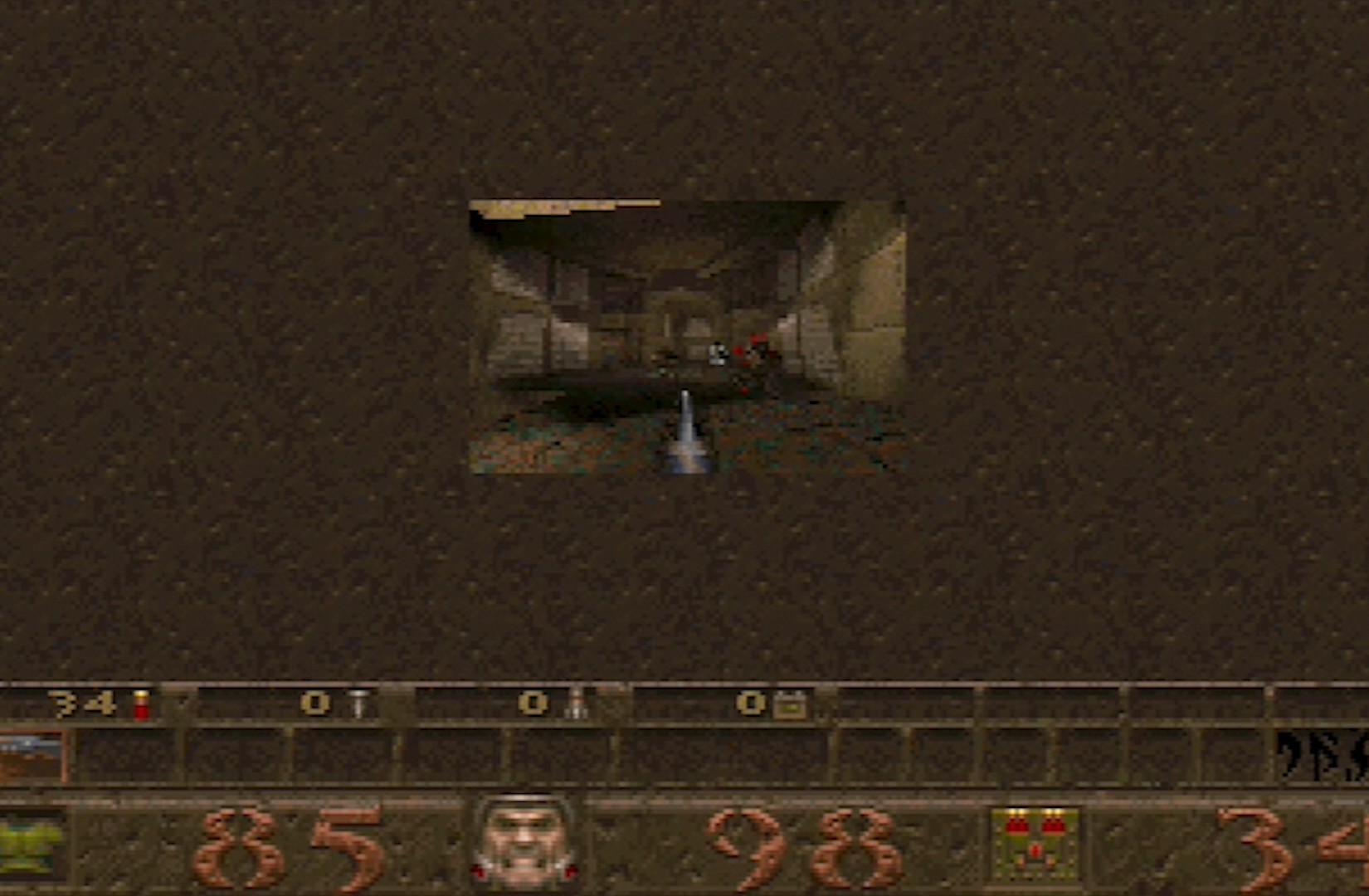
But in 2D the situation improves somewhat. Let's say the same Rayman works most of the time without brakes, which is truly amazing, because In the minimum system requirements, the first Pentium at 90 MHz is already indicated.
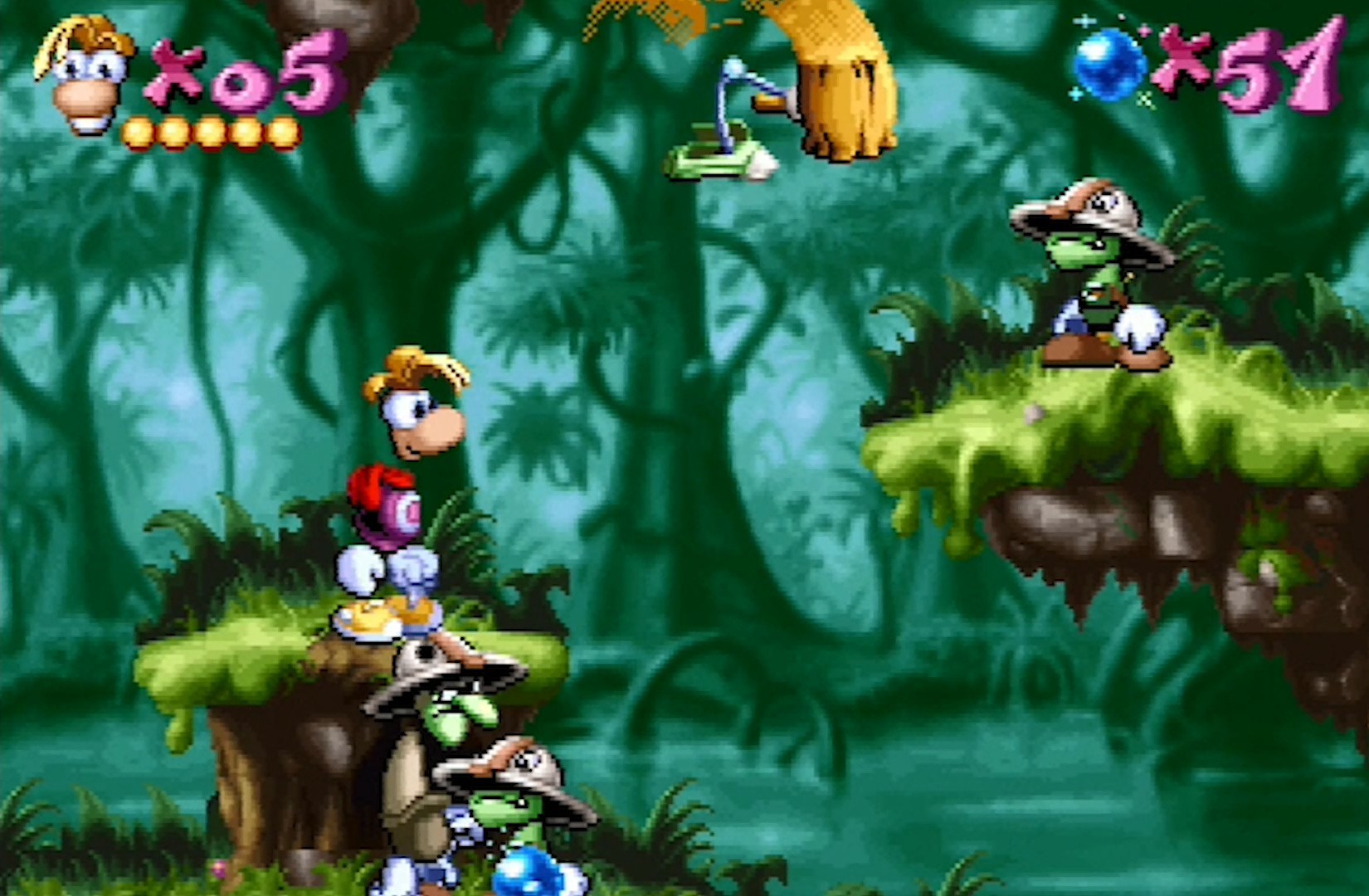
No less good is the situation and the game Warcraft 2, or, more precisely, "Warcraft 2" according to the cool team of localizers of the SEC. In some places, the problems of capturing video make themselves felt, strangely painting places covered with fog of war, as well as cropping the picture to the left, but at first glance this is the only problem, and there is complete order with the speed of work. The game still occasionally slows down, but only at the moment of camera movement and simultaneous movement of units. Ie, until you move the camera - the speed is perfect. On the other hand, I noticed this not immediately, this does not prevent a drop from playing.


And finally - a few words about multimedia capabilities. The microphone writes in general is not bad, but because the computer itself is noisy - the sound is noisy. As for the music - under Windows neither MP3 nor WAV without brakes could be played, it is very slow.
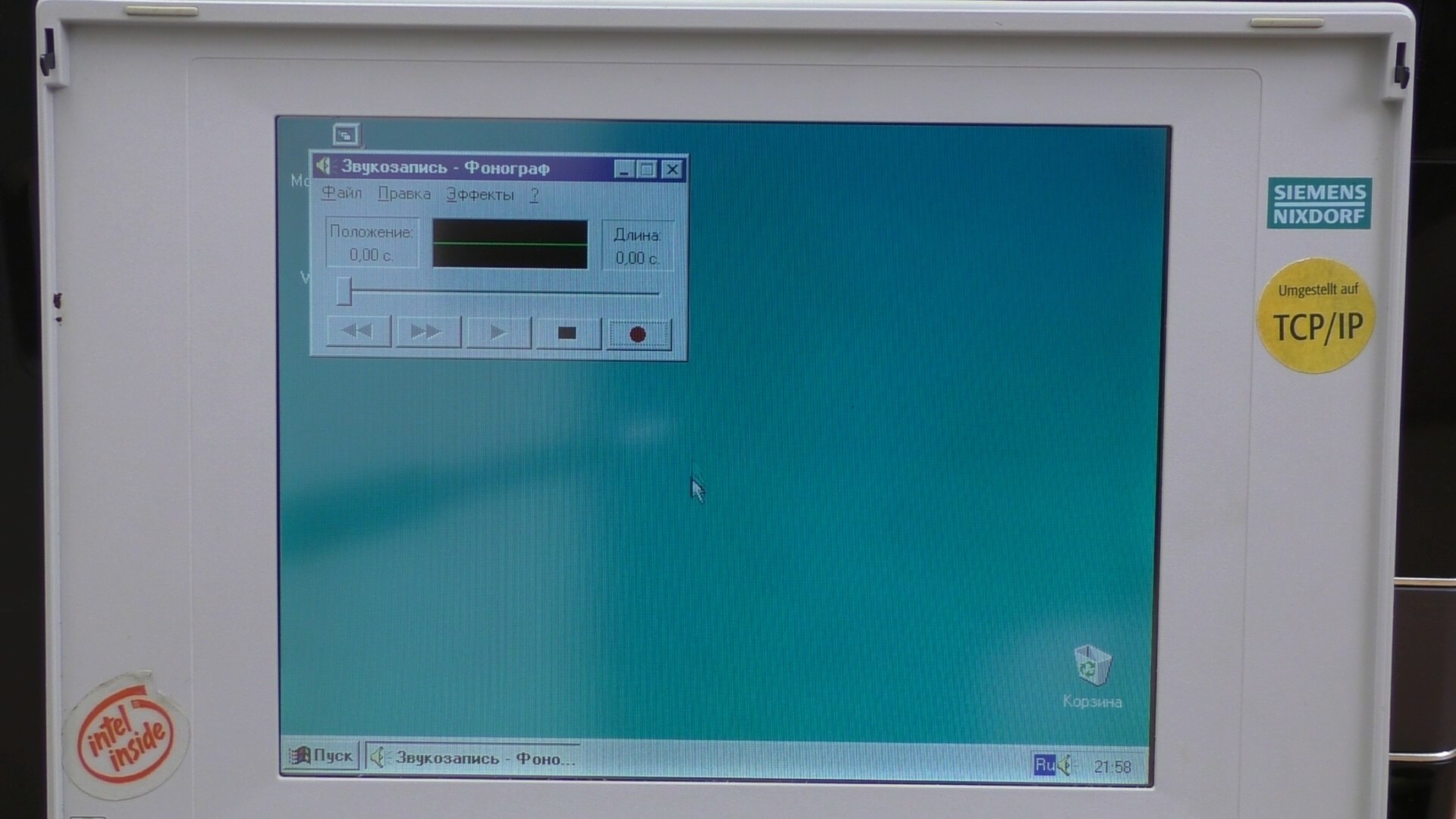
But under DOS, the situation changes somewhat. Yes, MP3 files still stutter badly, but with WAV, i.e. audio files without compression everything went much better. Want to see and hear - enjoy your video!
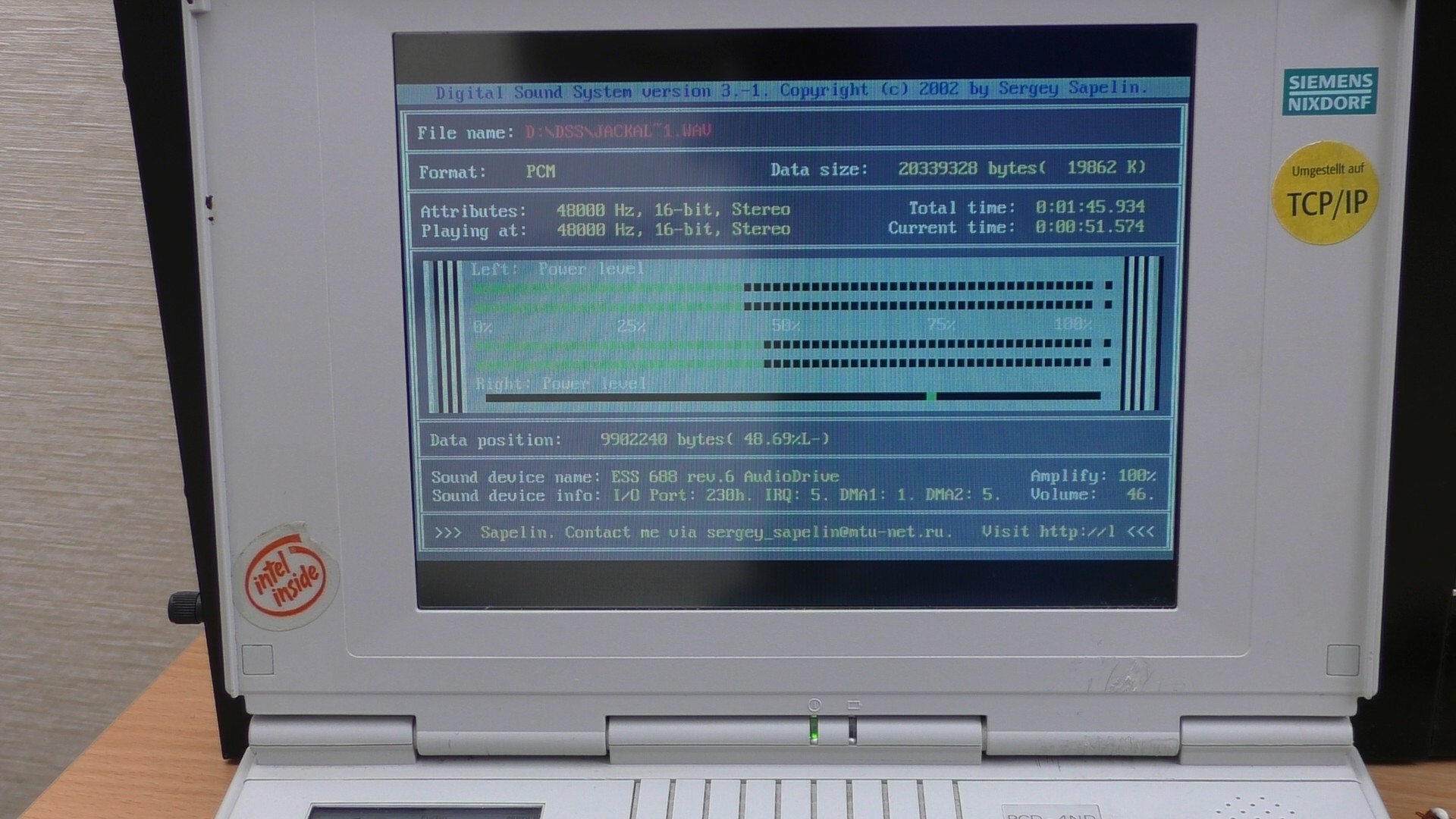
PS The pictures of the games are cropped on the left not by malicious intent - just like that, the capture board decided to understand the video signal from the laptop.
The laptop has survived quite well, although as a matte cover it is clear that the life of the laptop was eventful.

')
Nearly in the center we have a built-in microphone hiding, which is quite unusual for old laptops I have seen.

On the right is a typical drive for 3 and a half inches, and still working, and at the front left - pretty weighty, but alas, already dead battery. A striking difference from modern laptops, where the battery is most often located behind.


Flopik, making some significant enough effort, can also be pulled out and replaced with an additional battery. Curious move.

By the way, according to the documentation, this model was originally supplied with 4 MB of RAM, but judging by the inscriptions on the bottom cover, later revisions were upgraded to the full.

On the right, the laptop has a connector for connecting the power supply, and under the cover there are separate PS / 2 ports for connecting an external mouse and keyboard. Separate, this is important: on older laptops, sometimes these ports were combined into one.


On the left are the PCMCIA connector for expansion cards like network, USB and so on. Standard connectors for connecting external speakers and, according to documentation, linear audio output huddle alongside.

The microphone port is, oddly enough, located at the back.

Unusual solution. Also located in the back, from right to left:

COM port for connecting mice or other slow equipment;
VGA port for connecting an external monitor;
LPT, which is also parallel, also known as a printer port, which allows the use of faster hardware;
and of course, a proprietary expansion port that allows you to connect to the docking station with additional equipment. Such docks were a typical feature of laptops of those years, but today they almost everywhere have sunk into oblivion.

Under the lid, a 10-inch monitor is waiting for us, but unfortunately, over the years, the hinges are so well loosened, and it is not fixed in any of the positions. I deliberately did not even try to repair it in any way in order to show you how it happens in life. Personally, I see this for the first time.

Under the display, besides a pair of LED indicators, there is also a socket hiding, when turned on, showing some technical information. Funny thing, I even slightly regret that it has ceased to be fashionable.

On the right side of the speaker stays in a single copy, as well as the power button, there is nothing unusual here.

But for what purposes, except as aesthetic, this thing is needed - I do not have a single idea. To record reminders, what key does it mean? In general, if you have thoughts on this subject - write in the comments.


Under the keyboard is a trackball with two buttons. Quite a curious thing, the buttons are pressed well, but I personally lack sensitivity, even after cleaning the ball.

Finally, the keyboard.

As you can see, initially there were no Russian designations on it, they were pasted later, moreover, they were pasted qualitatively, and over the years they were not erased. Alas, because of the rather large keys, the delete, home and end buttons are located atypically.

It also infuriates the location of the Fn key - on a normal keyboard in this place there is an alt, and if you try without looking at the keyboard in Windows, press the Alt + F4 combination and you go to Fn + F4 - the laptop will go to sleep, and this is very bad.

After switching on, the laptop happily reports that it already has power at 50 MHz, and that in order to go to the BIOS settings, you need to hold down the not very typical Fnc + ESCAPE key combination. These settings look pretty ordinary and include almost the same as today, say, download sequence, date change, password protection, and so on.



There is also a monitor mode switch, where you can choose whether to stretch the image in a low resolution with or without proportions, it did not affect the performance. The picture on the external monitor in the duplication mode will be displayed in the same mode.

The video card here is from Western Digital, which made, as we see, not only hard drives.


Now about performance. There is much clearer to watch the video, so in the form of text I will describe everything briefly.
Doom 2 - sometimes slows down a bit, but in general - playable. And if you reduce the size of the screen - then the brakes evaporate.

Decscent II slows down noticeably more at 320x200, and at 640x480, we switch to a slide show at all.

But Quake slows down as not in itself. More or less normally, you can play only 320x200 and unscrew the screen size to a minimum. The game at the same time still slows down, but everything else also becomes VERY difficult to understand what happens there damn it! The situation, however, is quite predictable: 486DX4 / 100 MHz is specified in the minimum system requirements.

But in 2D the situation improves somewhat. Let's say the same Rayman works most of the time without brakes, which is truly amazing, because In the minimum system requirements, the first Pentium at 90 MHz is already indicated.

No less good is the situation and the game Warcraft 2, or, more precisely, "Warcraft 2" according to the cool team of localizers of the SEC. In some places, the problems of capturing video make themselves felt, strangely painting places covered with fog of war, as well as cropping the picture to the left, but at first glance this is the only problem, and there is complete order with the speed of work. The game still occasionally slows down, but only at the moment of camera movement and simultaneous movement of units. Ie, until you move the camera - the speed is perfect. On the other hand, I noticed this not immediately, this does not prevent a drop from playing.


And finally - a few words about multimedia capabilities. The microphone writes in general is not bad, but because the computer itself is noisy - the sound is noisy. As for the music - under Windows neither MP3 nor WAV without brakes could be played, it is very slow.

But under DOS, the situation changes somewhat. Yes, MP3 files still stutter badly, but with WAV, i.e. audio files without compression everything went much better. Want to see and hear - enjoy your video!

PS The pictures of the games are cropped on the left not by malicious intent - just like that, the capture board decided to understand the video signal from the laptop.
Source: https://habr.com/ru/post/372717/
All Articles